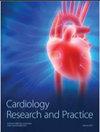Integrative Single-Cell Analysis of Cardiomyopathy Identifies Differences in Cell Stemness and Transcriptional Regulatory Networks among Fibroblast Subpopulations
IF 1.8
4区 医学
Q3 CARDIAC & CARDIOVASCULAR SYSTEMS
引用次数: 0
Abstract
Background. Cardiomyopathy encompasses a broad spectrum of diseases affecting myocardial tissue, characterized clinically by abnormalities in cardiac structure, heart failure, and/or arrhythmias. Clinically heterogeneous, major types include dilated cardiomyopathy (DCM), hypertrophic cardiomyopathy (HCM), restrictive cardiomyopathy (RM), ischemic cardiomyopathy (ICM), among which DCM is more prevalent, while ICM exhibits higher incidence and mortality rates. Myocardial injury during cardiomyopathy progression may lead to myocardial fibrosis. Failure to intervene early and inhibit the process of myocardial fibrosis may culminate in heart failure. Cardiac fibroblasts constitute crucial cellular components determining the extent and quality of myocardial fibrosis, with various subpopulations exerting diverse roles in cardiomyopathy progression. Despite this, understanding of the cellular plasticity and transcriptional regulatory networks of cardiac fibroblasts in cardiomyopathy remains limited. Therefore, in this study, we conducted comprehensive single-cell analysis of cardiac fibroblasts in cardiomyopathy to explore differences in cellular plasticity and transcriptional regulatory networks among fibroblast subpopulations, with the aim of providing as many useful references as possible for the diagnosis, prognosis, and treatment of cardiomyopathy. Materials and Methods. Cells with mitochondrial gene expression comprising >20% of total expressed genes were excluded. Differential expression genes (DEGs) and stemness genes within cardiac fibroblast subpopulations were subjected to Gene Ontology (GO) analysis of biological processes (BP) and AUCell analysis. Monocle software was employed to analyze the pseudo-temporal trajectory of cardiac fibroblasts in cardiomyopathy. Additionally, the Python package SCENIC was utilized to assess enrichment of transcription factors and activity of regulators within cardiac fibroblast subpopulations in cardiomyopathy. Results. Following batch effect correction, 179,927 cells were clustered into 32 clusters, designated as T_NK cells, endothelial cells, myeloid cells, fibroblasts, pericytes, SMCs, CMs, proliferating cells, EndoCs, and EPCs. Among them, 8148 fibroblasts were further subdivided into 4 subpopulations, namely C0 THBS4+ Fibroblasts, C1 LINC01133+ Fibroblasts, C2 FGF7+ Fibroblasts, and C3 AGT + Fibroblasts. Results from GO_BP and AUCell analyses suggest that C3 AGT + Fibroblasts may be associated with immune response activation, protein transport, and myocardial contractile function, correlating with disease progression in cardiomyopathy. Transcription factor enrichment analysis indicates that FOS is the most significant TF in C3 AGT + Fibroblasts, also associated with the M1 module, possibly implicated in protein hydrolysis, intracellular DNA replication, and cell proliferation. Moreover, correlation analysis of transcriptional regulatory activity between fibroblast subpopulations reveals a more pronounced heterogeneity within C3 AGT + Fibroblasts in cardiomyopathy. Conclusion. C3 AGT + Fibroblasts exhibit increased sensitivity towards adverse outcomes in cardiomyopathy, such as myocardial fibrosis and impaired cardiac contractile function, compared to other cardiac fibroblast subpopulations. The differential cellular plasticity and transcriptional regulatory activity between C3 AGT + Fibroblasts and other subgroups offer new perspectives for targeting fibroblast subpopulation activity to treat cardiomyopathy. Additionally, stemness genes EPAS1 and MYC, along with the regulator FOS, may play roles in modulating the biological processes of cardiac fibroblasts in cardiomyopathy.心肌病的单细胞整合分析确定了成纤维细胞亚群在细胞干性和转录调控网络方面的差异
背景。心肌病包括影响心肌组织的多种疾病,临床特征为心脏结构异常、心力衰竭和/或心律失常。临床上,心肌病的类型多种多样,主要包括扩张型心肌病(DCM)、肥厚型心肌病(HCM)、限制型心肌病(RM)和缺血性心肌病(ICM)。心肌病进展过程中的心肌损伤可能导致心肌纤维化。如果不能及早干预和抑制心肌纤维化过程,最终可能导致心力衰竭。心肌成纤维细胞是决定心肌纤维化程度和质量的关键细胞成分,不同的亚群在心肌病进展过程中发挥着不同的作用。尽管如此,人们对心肌病中心脏成纤维细胞的细胞可塑性和转录调控网络的了解仍然有限。因此,在本研究中,我们对心肌病中的心脏成纤维细胞进行了全面的单细胞分析,以探讨不同成纤维细胞亚群之间细胞可塑性和转录调控网络的差异,旨在为心肌病的诊断、预后和治疗提供尽可能多的有用参考。材料与方法。细胞中线粒体基因表达量占总表达量的 20%。对心脏成纤维细胞亚群中的差异表达基因(DEGs)和干性基因进行生物过程(BP)的基因本体(GO)分析和 AUCell 分析。利用Monocle软件分析了心肌病中心脏成纤维细胞的伪时间轨迹。此外,还利用 Python 软件包 SCENIC 评估了心肌病中心脏成纤维细胞亚群中转录因子的富集情况和调节因子的活性。结果经过批次效应校正,179,927 个细胞被聚类为 32 个细胞群,分别为 T_NK 细胞、内皮细胞、髓样细胞、成纤维细胞、周细胞、SMCs、CMs、增殖细胞、EndoCs 和 EPCs。其中,8148 个成纤维细胞被进一步细分为 4 个亚群,即 C0 THBS4+ 成纤维细胞、C1 LINC01133+ 成纤维细胞、C2 FGF7+ 成纤维细胞和 C3 AGT + 成纤维细胞。GO_BP 和 AUCell 分析结果表明,C3 AGT + 成纤维细胞可能与免疫反应激活、蛋白质转运和心肌收缩功能有关,与心肌病的疾病进展相关。转录因子富集分析表明,FOS 是 C3 AGT + 成纤维细胞中最重要的转录因子,也与 M1 模块有关,可能与蛋白质水解、细胞内 DNA 复制和细胞增殖有关。此外,成纤维细胞亚群之间转录调控活性的相关性分析表明,心肌病患者的 C3 AGT + 成纤维细胞内部存在更明显的异质性。结论与其他心脏成纤维细胞亚群相比,C3 AGT + 成纤维细胞对心肌病的不良后果(如心肌纤维化和心脏收缩功能受损)表现出更高的敏感性。C3 AGT +成纤维细胞与其他亚群之间不同的细胞可塑性和转录调控活性为靶向成纤维细胞亚群活性治疗心肌病提供了新的视角。此外,干性基因EPAS1和MYC以及调控因子FOS可能在心肌病中调节心脏成纤维细胞的生物学过程中发挥作用。
本文章由计算机程序翻译,如有差异,请以英文原文为准。
求助全文
约1分钟内获得全文
求助全文
来源期刊

Cardiology Research and Practice
Medicine-Cardiology and Cardiovascular Medicine
CiteScore
4.40
自引率
0.00%
发文量
64
审稿时长
13 weeks
期刊介绍:
Cardiology Research and Practice is a peer-reviewed, Open Access journal that publishes original research articles, review articles, and clinical studies that focus on the diagnosis and treatment of cardiovascular disease. The journal welcomes submissions related to systemic hypertension, arrhythmia, congestive heart failure, valvular heart disease, vascular disease, congenital heart disease, and cardiomyopathy.
 求助内容:
求助内容: 应助结果提醒方式:
应助结果提醒方式:


